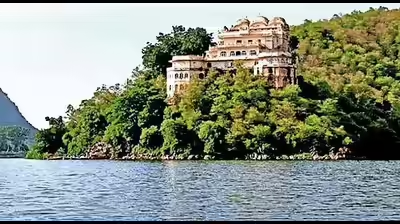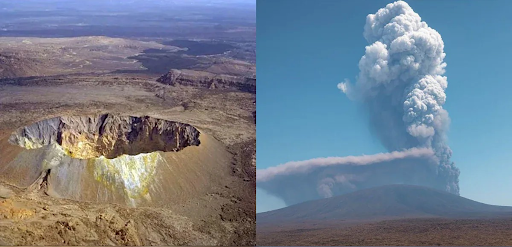




Disclaimer: Copyright infringement not intended.
Supreme Court decision mandates Rajasthan state government to dismantle & potentially relocate replica structures from Seven Wonders park situated in Ana Sagar Lake wetland area underscoring importance of preserving ecologically sensitive zones.
|
Feature |
Details |
|
Location |
Ajmer, Rajasthan, India |
|
Type |
Artificial freshwater wetland |
|
Built By |
Anaji Chauhan (Grandfather of Prithviraj Chauhan) in 1135-1150 AD |
|
Area |
Approx. 13 km² (including lake & surrounding wetland) |
|
Main Water Source |
Rainwater & feeder streams |
|
Ecological Importance |
Supports biodiversity, prevents flooding & acts as a water recharge zone |
|
Flora |
Aquatic plants, reeds, marsh vegetation |
|
Fauna |
Migratory birds (flamingos, pelicans, herons), fish, amphibians & reptiles |
|
Threats |
Encroachment, pollution, illegal constructions (e.g., ‘Seven Wonders Park’ replicas), urbanization |
|
Legal Protection |
Declared a wetland under Wetlands (Conservation & Management) Rules, 2017 |
|
Recent Supreme Court Order (2024) |
Directed removal of illegal replica structures from 'Seven Wonders Park' to protect wetland |
|
Category |
Details |
|
Location |
Ajmer, Rajasthan, India |
|
Type |
Artificial freshwater lake |
|
Geographical Coordinates |
26.4707° N, 74.6176° E |
|
Built By |
Arnoraja (Anaji) Chauhan, grandfather of Prithviraj Chauhan |
|
Year of Construction |
1135 - 1150 AD |
|
Purpose of Construction |
Water conservation & irrigation |
|
River Source |
Built by damming Luni or Lavanavari River |
|
Spread Over |
Approximately 13 sq km (1300 hectares) |
|
Depth |
Varies by season; significantly reduces in summer |
|
Water Sources |
Rainwater & feeder canals |
|
Drying Issue |
The lake dries up almost completely during summer months due to high evaporation & low water inflow |
|
Famous Structures |
Baradari (pavilions) built by Mughal Emperor Shah Jahan in 1637 AD |
|
Garden Nearby |
Daulat Bagh, built by Emperor Jahangir, located on eastern embankment of lake |
|
Island in Lake |
A small island in center of lake, accessible via boating |
|
Circuit House |
A British era Residency located on a hill near lake, now used as a government guest house |
|
Embankment Construction |
Constructed using stone masonry, reinforced over centuries |
|
Mughal Influence |
Mughal emperors contributed to its beautification with gardens, marble pavilions & embankments |
|
Tourism & Activities |
Boating, sunset views, picnicking, photography & walking trails around lake |
|
Best Time to Visit |
October to March (Winter months offer pleasant weather) |
|
Major Events/Festivals |
Urs Festival at Ajmer Sharif Dargah (nearby) |
|
Current Condition |
Faces pollution & seasonal water depletion, conservation efforts are ongoing |
|
Significance |
One of most important historical & recreational sites in Rajasthan |
|
Wetland Name |
Location |
Area (sq km) |
Type |
Ramsar Designation Year |
Key Features |
|
Chilika Lake |
Odisha |
1,165 |
Coastal Lagoon |
1981 |
Largest brackish water lagoon, migratory birds, Irrawaddy dolphins |
|
Keoladeo National Park |
Rajasthan |
28.73 |
Freshwater Marsh |
1981 |
UNESCO World Heritage Site, crucial bird sanctuary |
|
Sundarbans Wetland |
West Bengal |
4,267 |
Mangrove Forest |
2019 |
Largest mangrove ecosystem, Royal Bengal Tiger habitat |
|
Loktak Lake |
Manipur |
287 |
Freshwater Lake |
1990 |
Phumdis (floating vegetation), endangered Sangai deer |
|
Wular Lake |
Jammu & Kashmir |
189 |
Freshwater Lake |
1990 |
Largest freshwater lake in India, regulates hydrology |
|
Deepor Beel |
Assam |
40 |
Riverine Wetland |
2002 |
Important Bird Area, elephants frequent region |
|
Ropar Wetland |
Punjab |
13.65 |
Freshwater |
2002 |
Supports fish diversity, pollution from urban areas |
|
Sambhar Lake |
Rajasthan |
240 |
Saltwater Lake |
1990 |
Largest inland saltwater lake in India, flamingo breeding ground |
|
Ashtamudi Lake |
Kerala |
614 |
Estuarine |
2002 |
Famous for backwaters, coconut lagoons, fishing economy |
|
Nalsarovar Lake |
Gujarat |
120 |
Freshwater Lake |
2012 |
Important for flamingos, declared a bird sanctuary |
Ancient Seven Wonders of World:
|
Wonder |
Location |
Built By |
Year Built |
Current Status |
|
Great Pyramid of Giza |
Egypt |
Egyptians |
2560 BC |
Only surviving ancient wonder |
|
Hanging Gardens of Babylon |
Iraq (Mesopotamia) |
Babylonians |
600 BC |
Possibly mythical, no archaeological proof |
|
Statue of Zeus at Olympia |
Greece |
Greeks |
435 BC |
Destroyed in 5th century AD |
|
Temple of Artemis at Ephesus |
Turkey |
Greeks |
550 BC |
Destroyed by arson in 356 BC, later rebuilt, then destroyed by Goths |
|
Mausoleum at Halicarnassus |
Turkey |
Persians |
350 BC |
Destroyed by earthquakes |
|
Colossus of Rhodes |
Greece |
Greeks |
280 BC |
Destroyed by an earthquake in 226 BC |
|
Lighthouse of Alexandria |
Egypt |
Ptolemaic Kingdom |
280 BC |
Destroyed by an earthquake in 1323 AD |
New Seven Wonders of World (Declared in 2007):
|
Wonder |
Location |
Built By |
Year Built |
Key Features |
|
Great Wall of China |
China |
Chinese Dynasties |
7th Century BC |
Longest man-made structure in world |
|
Petra |
Jordan |
Nabataeans |
312 BC |
Rock-cut architecture, famous for Al-Khazneh |
|
Christ Redeemer |
Brazil |
Catholic Church |
1931 |
98-ft tall statue of Jesus, symbol of Christianity |
|
Machu Picchu |
Peru |
Incas |
1450 AD |
Lost city of Incas, high-altitude ruins |
|
Chichen Itza |
Mexico |
Mayans |
600 AD |
Pyramid of Kukulkan, Mayan astronomical significance |
|
Colosseum |
Italy |
Romans |
80 AD |
Largest amphitheater in world |
|
Taj Mahal |
India |
Mughal Emperor Shah Jahan |
1632 AD |
UNESCO World Heritage Site, symbol of love |
For more information, please refer to IAS GYAN
Sources:
|
PRACTICE QUESTION Q. Construction of artificial lakes like Ana Sagar in medieval India reflects an advanced understanding of water conservation & urban planning. Critically analyze historical, ecological, socio economic impacts of such water bodies in Indian subcontinent. |






© 2025 iasgyan. All right reserved